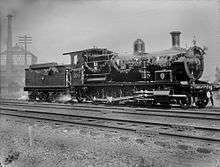New South Wales D53 class locomotive
|
Class D53 Locomotive | |||||||||||||||||||||||||||||||
| |||||||||||||||||||||||||||||||
| |||||||||||||||||||||||||||||||
| |||||||||||||||||||||||||||||||
| |||||||||||||||||||||||||||||||
The D53 class was a class of 2-8-0 steam locomotives built for the New South Wales Government Railways of Australia.
History
This class of locomotive was designed by the New South Wales Government Railways as an improved version of the T class. All the coupled wheels had flanges and a certain amount of side movement was given to the middle pairs with a laterally operating knuckle joint being provided in the middle section of the coupling rods.
Clyde Engineering delivered the first locomotive in April 1912 and by November 1917, a total of 190 were in service. Most were fitted with superheaters when built and some fitted at a later date. There was a problem with the locomotives being unbalanced, causing speed restrictions to be imposed to avoid rough riding and track damage. Following further investigations, 24 of the class received balanced coupled wheels and these were permitted to operate at higher speed on mail and fruit trains.[1][2]
When introduced, most of the class were fitted with a standard bogie tender, similar as those attached to the 50 class, although some saw service with large capacity "Wampu" tenders. In the later period of their lives, the majority were fitted with larger turret type tenders. In later years some were used as heavy shunting locomotives and from 1963 on some of these had automatic couplers fitted to the front.[2]
Following the removal of the knuckle joints from the coupling rods, flanges from the second coupled and driving wheels and the fitting of boilers standard for 50 class; 53 class and 55 class, they became most useful locomotives.[2]
The 24 not fitted with superheaters were scrapped in the 1930s. The first superheated example was withdrawn in January 1957 with the fleet down to 39 by July 1969 with the last withdrawn in January 1973.[1]
The Commonwealth Railways used the design of these locomotives for their 26 strong KA class for the Trans-Australian Railway.[2]
Preservation
Three have been preserved:
- 5353 by Dorrigo Steam Railway and Museum www.dsrm.org.au. 5353 was built by the N.S.W. Government Railways in 1913, Builder's number 80 and was withdrawn from service in December 1972. It travelled over 1.8 million miles. It was Superheated when built. It was the last 53 class to be overhauled, a contributing reason why it was chosen for preservation by Dorrigo Steam Railway and Museum. It has a Turret Tender.
- 5367 by the Lachlan Valley Railway, overhauled and returned to service 1980, withdrawn 1988, overhauled and returned to service September 1995[3] currently out of service at Cowra Locomotive Depot waiting repair [4] 5367 was built by Clyde Engineering in 1914, Builder's Number 122 and was withdrawn during July 1972. 5367 was the last steam locomotive to be allocated to Parkes, in 1971 and was given the nickname 'Rosie,' which is why it was chosen for preservation. It has a Turret Tender.
- 5461 by the New South Wales Rail Transport Museum, operational until at least June 1975 before being overhauled and returned to service in October 1981, withdrawn in December 1985 and transferred to Valley Heights Locomotive Depot Heritage Museum by 1999[5][6][7] 5461 was built by Clyde Engineering in 1916, Builder's Number 210) and was withdrawn from service in May 1967. 5461 was the infamous TF 1174 of post W.W.I notoriety, which is why it was chosen for preservation. Currently 5461 has a Wampu Tender.
Gallery
 200th steam locomotive built by Clyde TF 1164 from The Powerhouse
200th steam locomotive built by Clyde TF 1164 from The Powerhouse Locomotive 5395 stands at Thirroul with a Workers' Train from Port Kembla
Locomotive 5395 stands at Thirroul with a Workers' Train from Port Kembla
See also
References
- 1 2 Oberg, Leon (1984). Locomotives of Australia 1850's - 1980's. Frenchs Forest: Reed Books. pp. 107–108. ISBN 0 730100 05 7.
- 1 2 3 4 Grunbach, Alex (1989). A Compendium of New South Wales Steam Locomotives. Sydney: Australian Railway Historical Society, NSW Division. pp. 152–155. ISBN 0 909650 27 6.
- ↑ "Preservation and Tourist News" Railway Digest December 1995 page 47
- ↑ "Lachlan Valley Railway Rolling Stock". Retrieved 26 January 2016.
- ↑ "Museum on the Move" Roundhouse July 1976 page 16
- ↑ "Museum Scene" Roundhouse January 1982 page 24
- ↑ "Travel Scene" Roundhouse January 1991 page 19
